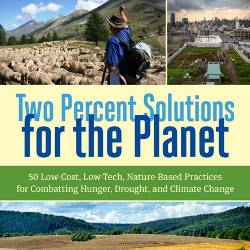[ English | Español ]
Author: Courtney White
“Dec 1, 2015, will be one of the most important days in human history. It will be seen as the tipping point when the world was saved from catastrophic climate change.” – André Leu, President of the IFOAM (Organics International)
One of the most significant events at the recent UN climate summit in Paris went largely unnoticed.
We know the headlines: In an effort to slow dangerous climate change, representatives from 197 nations concluded a two-week marathon of negotiations by signing a breakthrough agreement that commits governments to targeted reductions in greenhouse gas emissions starting in 2020.
This was justifiably big news. After 20 years of failed attempts to craft an international consensus on climate action, most spectacularly in Copenhagen in 2009, the world simply had to get its act together. It did so, to well-earned applause, on December 12, 2015.
So what happened on December 1?
That’s the day the French government launched the 4 per 1000 Initiative: Soils for Food Security and Climate, a plan to fight climate change with soil carbon. The initiative’s goal is this: to increase global soil carbon stocks by 0.4 percent per year by drawing down atmospheric carbon dioxide (CO2) via the increased photosynthesis of regenerative farming and land use.
On the surface, that may not sound like a lot of carbon, (it amounts to 10 billion tons of carbon per year sequestered in global soils), but French scientists say it’s enough to halt human-induced annual increases in CO2 globally.
That sounds like a front page headline to me!
How will the initiative succeed? The key is regenerative agriculture. France, for example, intends to hit its 4/1000 target by employing agro-ecological practices on 50 percent of its farms by 2020.
Agro-ecological practices restore damaged land and build biologically healthy soil through the use of cover crops, perennial plants, no-till farming, and livestock grazing patterns that mimic nature. If managed properly, these nature-based practices not only increase carbon stocks in soil, they also can dramatically reduce the amount of greenhouse gases produced by the use of fossil fuel in industrial agriculture, one of the biggest polluters on the planet.
Agro-ecological practices also increase resilience to climate change. In an op-ed published days after the French announcement in Paris, Michael Pollan and Deborah Barker wrote:
Regenerative farming would also increase the fertility of the land, making it more productive and better able to absorb and hold water, a critical function especially in times of climate-related floods and droughts. Carbon-rich fields require less synthetic nitrogen fertilizer and generate more productive crops, cutting farmer expenses.
Those are bold, but as we’ll see later, realistic claims. But here’s the best news: Regenerative agriculture is a shovel-ready solution to climate change.
Agro-ecological practices are practical, profitable and have been ground-tested by farmers and ranchers around the world for decades. In fact, shovel-readiness is a big reason why more than 100 nations, international NGOs and farmers’ organizations signed onto the 4/1000 Initiative–and why many more have signed on since then.
After years of neglect, soil carbon is now viewed as key to how the world manages climate change. “[It] has become a global initiative,” said French Agriculture Minister Stéphane Le Foll. “We need to mobilize even more stakeholders in a transition to achieve both food security and climate mitigation thanks to agriculture.”
“The time for talking is finished,” said IFOAM’s André Leu. “Now is the time for doing. The technology is available to everyone. It is up to us to mobilize in time. Let’s start working to get this done and give our world a better future.”
Paying for regeneration
A critical step will be creating a viable carbon economy where regenerative farmers and ranchers can be paid to build soil carbon. This has been a difficult challenge so far, but thanks to the Paris Agreement, 197 nations now have a huge incentive to draw down their emissions to meet official targets. And regenerative agriculture can help get them there.
From the carbon emitter’s perspective, offsetting carbon dioxide emissions with verifiable increases in soil carbon, validated now by the French government’s 4/1000 Initiative, will likely stimulate other nations to create market-based mechanisms which, in turn, will encourage farmers and ranchers to adopt regenerative practices, round and round. From society’s perspective, all this is great news!
Creating carbon markets isn’t a new idea. Over the past twenty years, a variety of efforts have been made to energize a voluntary carbon credit trading system, including programs in Europe, Australia, New England, California, and Vancouver, British Columbia, each with varying degrees of success. In New Mexico, where I live, the state legislature considered a bill in 2015 that would have created a policy framework for enacting a carbon credit system–a first for the state.
New Mexico attempted to established a carbon credit as a contract right and to create a five-member board to review and audit the credits as potential offsets for carbon emitters. The board specifically identified the removal of greenhouse gases from the atmosphere and its accumulation within plants, soils and geologic formations as a legitimate means by which a credit can be created–also a first (specifically, one carbon credit equaled one metric ton of CO2 or its equivalent).
Unfortunately, the bill didn’t become law, and it’s not the only model for paying for regeneration. But the bill represents an important step toward stimulating market-based responses to climate change.
Serious concerns about the shortcomings of carbon offset markets (sometimes called cap-and-trade) have been raised. This is especially true for organic, regenerative and family-scale agriculture, which could easily be pushed aside by large industrial producers. Here’s a useful primer on how climate-friendly agriculture can be treated fairly in a carbon economy.
The bottom line is this: We need state and federal policies that make the polluters pay, create publicly-controlled pools of money, and pay regenerative farmers and ranchers for building carbon stocks in their soils.
Science is on our side
Markets and their regulators will require sound science and hard numbers–credible and verifiable–to work effectively. This is a challenge, however, because understanding soil carbon involves chemistry, biology, ecology, hydrology, and agronomy—which means the science can get complex quickly, for researchers and laypeople alike. Fortunately, there has been a veritable explosion of soil carbon science recently, creating a clearer portrait of carbon’s potentials.
One researcher whose work has shed exciting light on regenerative agriculture is Dr. David Johnson, a molecular biologist at New Mexico State University. Johnson believes that “getting the biology right” is critical to creating significant increases in soil carbon stocks.
It’s essentially a two-step process, according to Johnson: (1) get life back into soils that have been stripped of their biological fertility by industrial agriculture; and (2) employ practices that bring about a shift in the soil from bacteria-dominated to fungi-dominated communities. The latter is important because fungi are the “carbon brokers” between plant roots and soil microbes. This process also improves soil structure which improves its ability to resist erosion–equally crucial to long-term carbon storage.
Of course, all of this soil rebuilding can be undone by the plow, which exposes microbes to the killing effect of heat and light. That’s why not turning the soil over is a key component of regenerative agriculture.
Johnson’s research also shows that “getting the biology right” reduces the amount of carbon that is “burped” back into the atmosphere (as CO2) by microbes as a waste product. This is important because the viability of long-term carbon storage in soils–and thus the size of monetary payments to farmers and ranchers from markets–depend on there being more carbon flowing into the soil system than flowing back out.
It’s not just about money. Additional carbon improves plant productivity, improves water infiltration and soil water-holding capacity, reduces the use of synthetic amendments, and promotes a healthy environment for pollinators and other beneficial insects.
A win-win for the land and ourselves!
Johnson notes that nature is three to four times more productive than any agricultural system yet devised by humans. And nature achieves that productivity without pesticides, synthetic amendments, irrigation or monocropping.
“Shouldn’t we be asking what we’re doing wrong?” Johnson said in an interview. “Plus, nature had the capacity to increase soil carbon in the past. Our task is to find out how it was done and mimic it in our current practices.”
Improved soil fertility, better food, more efficient use of water, reduced pollution, fewer energy requirements, better animal health, increased biodiversity, and keeping global warming in check–all possible for as little as 4 per 1000 a year!
For more information see:
Carbon Sequestration Potential on Agricultural Land by Daniel Kane, National Sustainable Agriculture Coalition
Soil Carbon Restoration: Can Biology Do the Job? by Jack Kittredge, Northeast Organic Farming Association
***
Courtney White, co-founder and former executive director of the Quivira Coalition, is the author of multiple essays and books, including “Grass, Soil, Hope: A Journey Through Carbon Country” and “The Age of Consequences.”


